1964 CHEVROLET CORVETTE brake
[x] Cancel search: brakePage 5 of 52
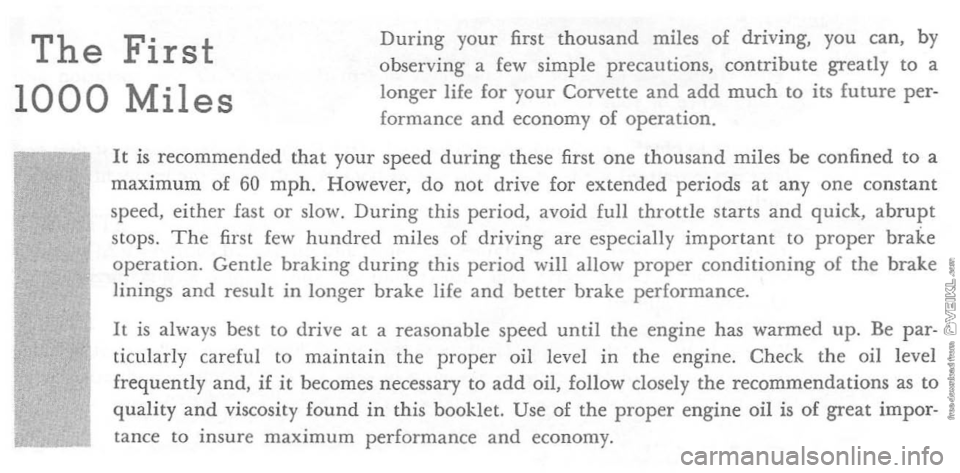
The First
1000 Miles
During your first thousand miles of driving, you can, by
observing a few simple precautions. contribute greatly to a
longer life for your Corvette
and add much to its future per
formance and economy of operation.
It
is recommended that your speed during these first one thousand miles be confined to a maximum of 60 mph. However, do not drive for extended periods at anyone constant
speed, either fast or slow. During this period, avoid full throttle starts and quick, abrupt stops. The first few hundred miles of driving are especially important to proper brake
operation. Gentle braking during this period will allow proper conditioning of the brake
linings and result in longer brake life and better brake performance.
It
is always best to drive at a reasonable speed until the engine has warmed up. Be particularly careful to maintain the proper oil level in the engine. Check the oil level
fre quently and, if it becomes necessary to add oil, follow closely the recommendations as to
quality and viscosity found in this booklet. Use of the proper engine oil is of great impor
tance to insure maximum performance and economy.
Page 8 of 52

Driving with the Powerg lide Transmission
The optional Powerglide is a completely automatic transmission which replaces the standard clutch and transmission. After starting the engine with the seIce-
P-PARK R-REVERSE N-NEUTRAL
D - DRIVE
L-LOW
tor !ever in "N" (Neutral) or "P" (Park) position, merely select the range desired and depress the accelerator. The transmission will do the rest.
Use only
when car is stopped. Car parked
For backing car-from stop.
For
standing-brakes applied. Normal
For
all forward driving -step hard driving
on
accelerator for extra accelera-range
lion below 45 mph.
For
hard pulling at low speeds and Sand, snow, climbing or descending sleep mud and grades. Shift to L
only
below
steep grades 40 mph. ~I_, ~
POWERGLIDE DRIVING CAUTIONS
• Do not accelerate engine in L, D , or R with the brakes engaged. This can cause damage by overheating transmission.
•
Do not hold car on an upgrade by accelerating engine. Use brakes. •
Do not use Low position except for hard pulls at low
speed or down-hill braking at speeds below
40 MPH.
• Do not shift inw Reverse or Park before coming to a complete stop .
• Always engage
parking brake when parked.
I
J
Page 9 of 52
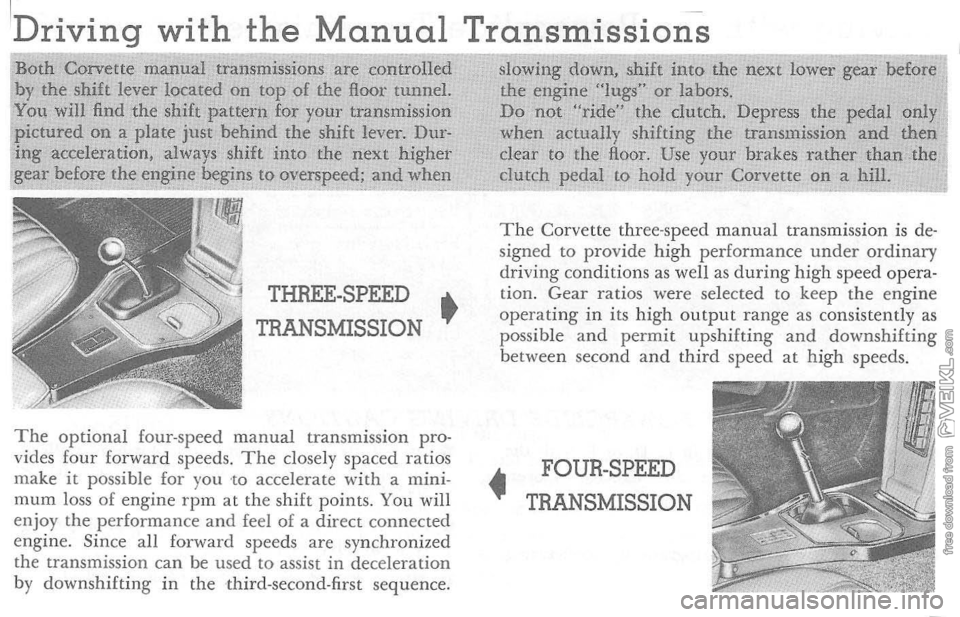
IDriving with the Manual Transmission-s
Both Corvette
manual transmissions are controlled slowing down, shift into the next lower gear before
by the shift lever located on top of the Hoor tunnel. the engine
"lugs" or labors.
You will find the shift pattern for your transmission Do not "ride" the dutch. Depress the pedal only pictured on a plate just behind the shift lever. Dur- when actually shifting the transmission and then ing acceleration, always shift into the next higher clear to the Hoar. Use your brakes rather than the
gear before the engine
begins to oVeISeeed; and ,;h_e_n~ __ cl_u_ tch_ pedal to hold your Corvette on a hill.
THREE-SPEED •
TRANSMISSION
The optional fouf4speed manual transmISSIOn provides four forward speeds. The closely spaced ratios
make it possible for you to accelerate with a mini
mum loss of engine rpm at the shift points. You will
en joy the performance and feel of a direct connecte d
engi ne. Since all forward speeds afe synchronized
the transmission can be used to assist in deceleration
by downshifting in the third-second-first sequence.
The Corvette three-speed manual transmission is designed to provide high performance under ordinary
driving conditions as well as during high speed opera
tion. Gear ratios were selected to keep the engine
operating in its high output range as consistently as possible and permit upshifting and downshifting
between second and third speed at high speeds.
• FOUR-SPEED
TRANSMISSION
Page 10 of 52
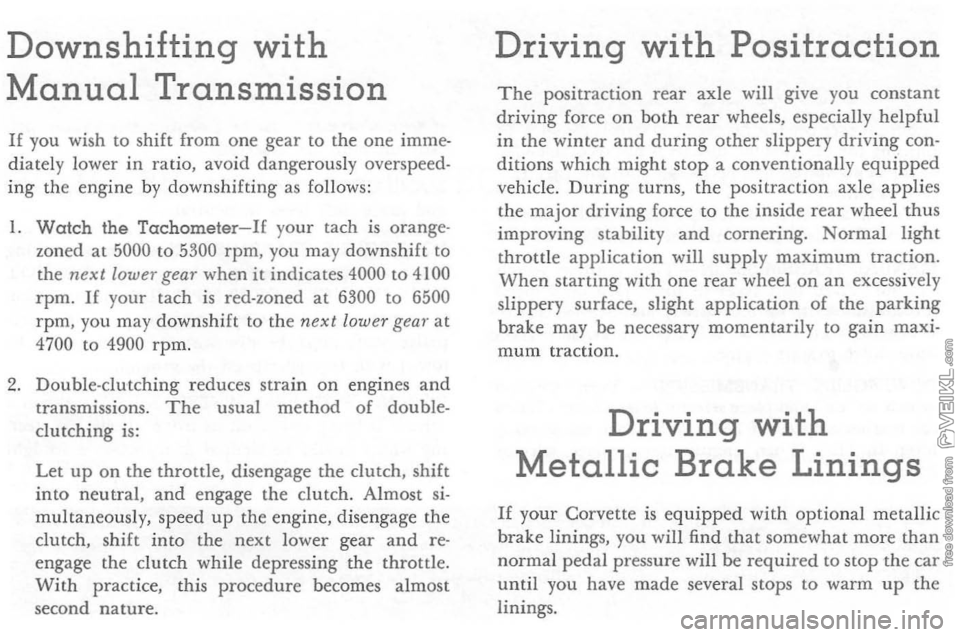
Downshifting with
Manual Transmission
If you wish to shift from one gear to the one imme
di ately lower in ratio, avoid dangerous ly overspeed
ing the engine by downshifting as follows:
I.
Watch the Tachometer-If your tach is orange
zoned at 5000 to 5300 rpm, you may downshift to
the next lower gear when it indicates 4000 to 4100
rpm. If your tach is red-zoned at 6300 to 6500 rpm, you may downshift to the next lower gear at 4700 to 4900 rpm.
2. Double-clutching reduces strain on engines and transmissions. The usual method of double
clutching is:
Let up on the throttle, disengage the clutch, shift
into neutral, and engage the clutch. Almost simultaneously, speed up the engine, disengage the
clutch, shift into the next lower gear and reengage the clutch while depressing the throttle.
With practice , this procedure becomes alm ost
second nature.
Driving with Positraction
The positraction rear axle will give you constant
driving force on both rear wheels, especially helpful in the winter and during other slippery driving con
ditions which might stop a conventionally equipped vehicle. During turns , the positraction axle applies
the major driving force to the inside rear wheel thus
improving stability and cornering. Normal light throttle application will supply maximum traction.
When starting with one rear wheel on an excessive ly
slippery surface, slight application of the
parking brake may be necessary momentarily to gai n maxi
mum traction.
Driving with
Metallic Brake Linings
If your Corvette is equipped with optional metallic
brake linings, you will find that somewhat mor e than
normal pedal pressure will be required to stop the car
until you have made several stops to warm up the
linings .
Page 11 of 52
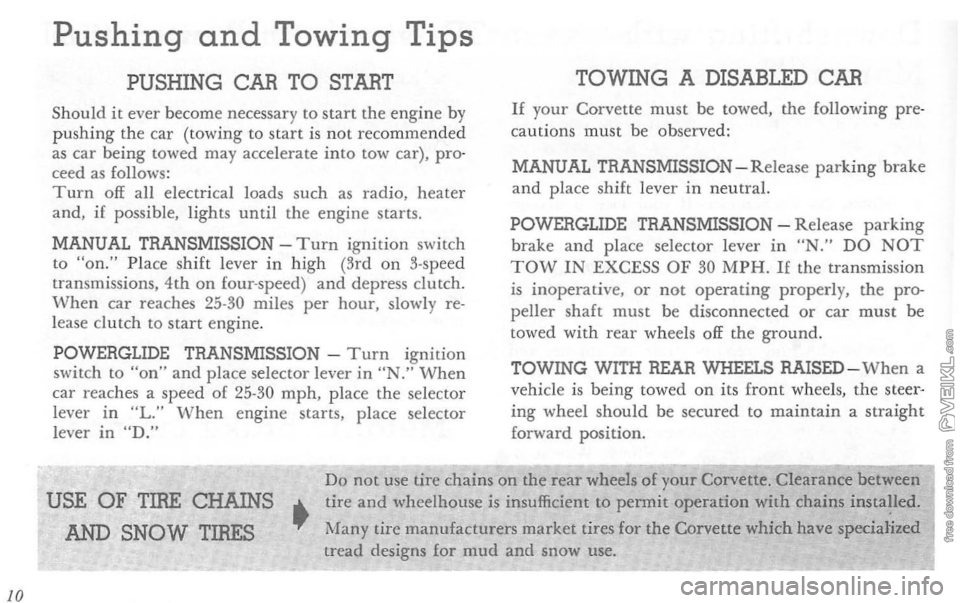
10
Pushing and Towing Tips
PUSHING CAR TO START
Should it ever beco me necessary to start the engine by
pu shing the car (towing to start is not recommended as car being towed may accelerate into tow car), pro
ceed as fo llows: Turn off all e lect rical loads su ch as radio, heater
and, if possible, lights until the engine st arts.
MANUAL TRANSMISSION - T
urn ignition switch
to "on." Place shift leve r in high (3rd on 3-spee d
transmissions, 4th on four-speed) and depress clutch. When car reaches 25-30 miles per hour, slowly re
l ease clutch to sta rt e ng ine.
POWERGLlDE TRANSMISSION -
Turn ignit io n
switch to "on" and place sel ector lever in "N." W h e n
car reac hes a spee d of 25-30 mph, place th e selecto r
l ever in
A DISABLED CAR
If your Corvette must be towed, the following pre
cautions must be observed:
MANUAL TRANSMISSION
-Release parking brake
and place shift lever in neutral.
POWERGLIDE TRANSMISSION -Release
parking brake and place selector lever in "N." DO NOT TOW IN EXCESS OF 30 MPH. II the transmission is inoperative, or not operating properly, the propeller shaft must b e d isconnected or car must be
towe d with rear wheels off the ground.
TOWING WITH REAR WHEELS
RAISED-When a
vehicle is being towed on its front wheels, the steer
ing whee l shou ld be secured to maintain a straight
forward position.
Do
not use tire chains on the rear wheels of your Corvette . Clearance between
USE OF TIRE CHAINS
AND SNOW TIRES
• tire and wheelhouse is insufficient to permit operation with chains insta!led.
Many [ire manufa cturers market tires for the Corvette which have specialized
tread designs for mud and snow use.
Page 12 of 52
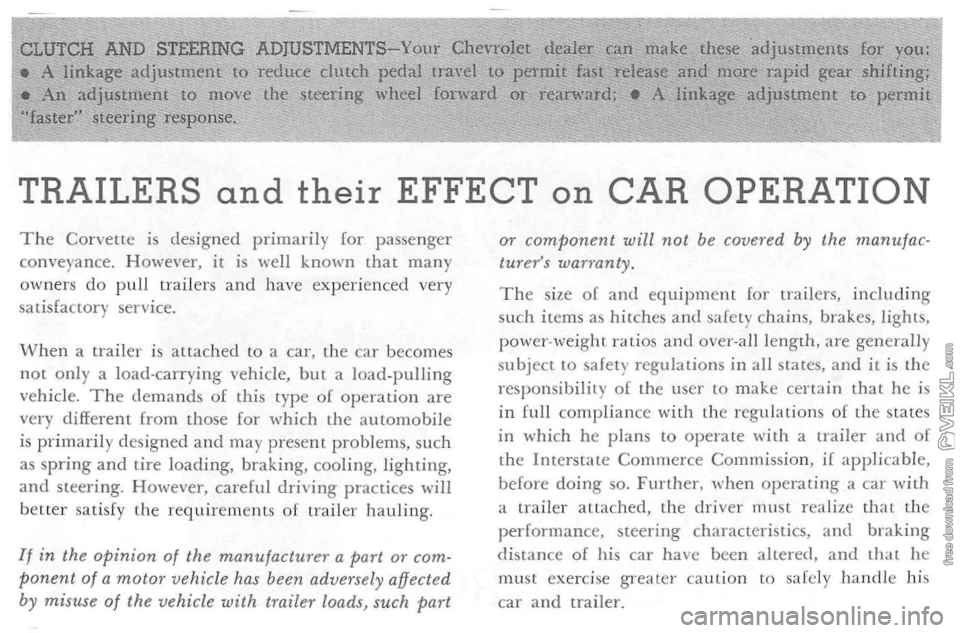
CLUTCH AND STEERING ADJUSTMENTS-Your Chevrolet deal!!! '?I.n make these 'adjustments for YQu: • A linkage adjustment to reduce clutch pedal travel to permit .fast release and more rapid gear shifting; • An adjustment to move the steering wheel forward or rearward; _ A linkage IIdjustment to permit
"faster" steering
response.
TRAILERS and their EFFECT on CAR OPERATION
The Corvette is designed primaril y (or passenge r
co nveyance . H owever , it is well known that many owners do pull trailers and have experi e nced very
sa tisfacLOry serv ice.
When a trailer is attached to a car, the car becomes
not only a l oad-carrying vehicle, but a load-pulling vehicle . The d e m a n ds of this type of operation are
very different from those (or which t h e automobile is pri ma rily designed and may present probl ems, such
as spring and tire loading, braking, coo ling, lighting, and steering. Howeve r, careful driving practices will
better s atisfy the requirements of trailer hauling.
If in the opinion of the manufacturer a part or com ponent of a motor vehicle has been advers ely affected
by misuse of the vehicle with trailer loads, such part or
com
ponent will not be covered by the manufacturers warranty .
The size o f and equipment for trailers, including
su ch ite ms as hitc hes and safe t y ch a ins, brakes, ligllls, pO\ve r- wei ght ratios a n d over-all length, are gen erally
su bject to safet y regulations in all states, and i t is the responsibility o f the u ser to m a ke certain that h e is in full compliance with th e regulations of the states
in which h e plans to opera te with a traile r and of t h e Interstate Commerce Commission, i f applicable,
before doing so . Furthe r , when opera tin g a car with a traile r attached, the drive r must realize tha t the performance, steering characte ri stics , a n d brakin g distance of his ca r h ave been altered , and that h e mlls t exe r c ise greater caution t o safe ly handle his
ca r and trailer.
Page 20 of 52
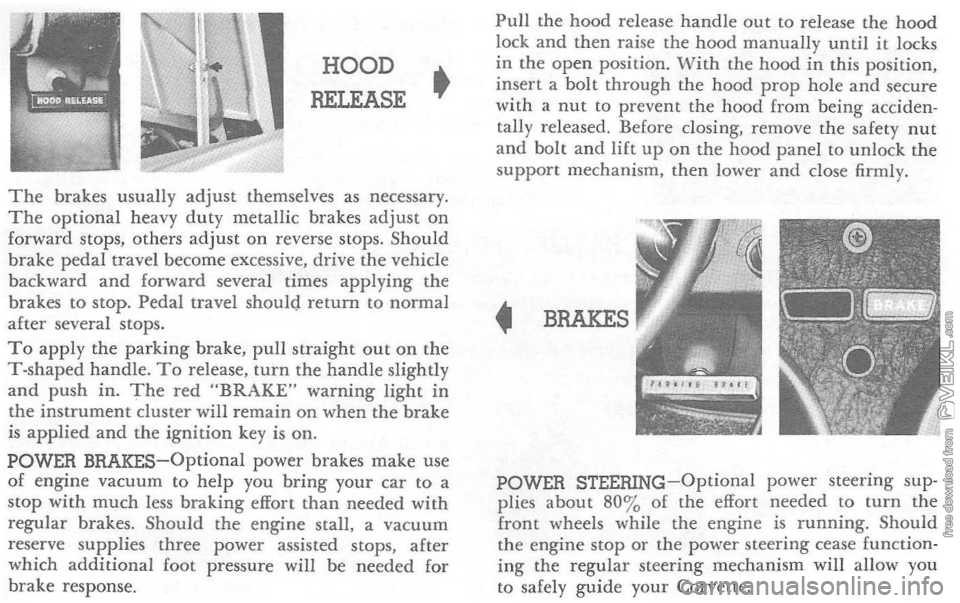
HOOD
RELEASE •
The brakes usually adjust themselves as necessary. The optional heavy duty metallic brakes adjust on forward stops, others adjust on reverse stops. Should
brake pedal travel become excessive, drive the vehicle
back ward
and forward several times applying the
brakes to stop. Pedal travel should return to normal after several stops. To apply the parking brake, pull straight out on the T-shaped handle. To release, turn the handle slightly and push in. The red "BRAKE" warning light in the instrument cluster will remain on when the brake is applied and the ignition key is on. POWER BRAKES-Optional power brakes make use of engine vacuum to help you bring your car to a stop with much less braking effort than needed with regular brakes. Should the engine stall. a vacuum
reserve supplies three power assisted stops, after
which additional foot pressure will be needed for
brake response.
Pull the hood release handle out to release the hood lock and then raise the hood manually until it locks
in the open position . With the hood in this position, insert a bolt through the hood prop hole and secure
with a nut to prevent the hood from being acciden
tally released. Before closing, remove the safety nut
and bolt and lift up on the hood panel to unlock the
support mechanism . then lower and close firmly.
• BRAKES
POWER STEERING-Optional power steering sup
plies about 80 % of the effort needed to turn the front wheels while the engine is running. Should the engine stop or the power steering cease function ing the regular steering mechanism will allow you
to safely guide your Corvette.
Page 35 of 52
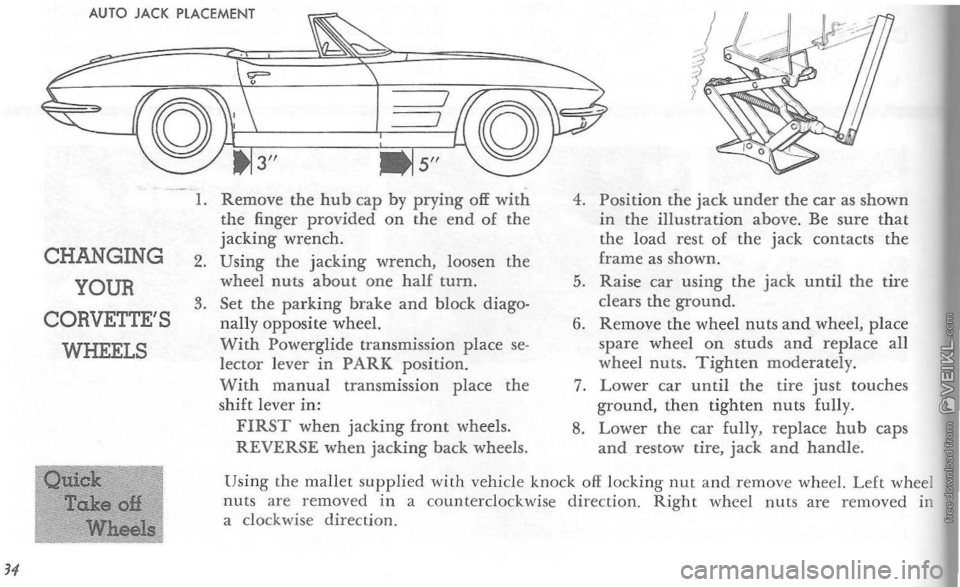
AUTO JACK PLACEMENT
CHANGING
YOUR
CORVETTE'S
WHEELS
1. Remove the hub cap by prying off with the finger provided on the end of the jacking wrench. 2. Using the jacking wrench, loosen the wheel nuts about one half turn. 3. Set the parking brake and block diago
nally opposite wheel.
With Powerglide transmission place selector lever in PARK position. With manual transmission place the
shift lever in:
FIRST when jacking front wheels. REVERSE when jacking back wheels. 4.
Position the jack under the car
as shown
in the illustration above. Be sure that
the
load rest of the jack contacts the frame as shown. 5. Raise car using the jack until the tire
clears the ground. 6. Remove the wheel nuts and wheel, place spare wheel on studs and replace all
whee l nuts. Tighten moderately. 7. Lower car until the tire just touches ground, then tighten nuts fully. 8. Lower the car fully , replace hub caps
and res-tow tire. jack and handl e .
Using the mallet supplied with vehicl e knock
off locking nut and remove wheel. Left whee l
nuts are removed in a counterclockwise direction. Right wheel nuts are removed in a clockwise direction.